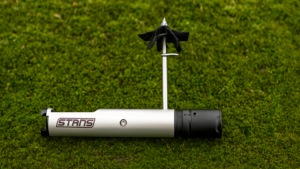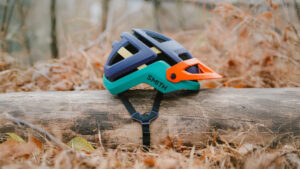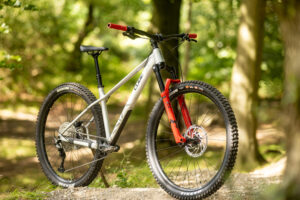Checking tyre pressures is part of the pre-ride ritual for every serious mountain biker. Here are the best tyre pressure gauges for the job.
Since the tyres on your bike are the only thing in contact with the trail, maintaining an optimum tyre pressure ensures maximum grip, support and braking traction. However, the tyres on your bike can leak air constantly, so you’ll need to check the pressure before every ride. You have two options – your thumb, or a properly calibrated pressure gauge.
You may also be interested in:
- Buyer’s guide to the best tubeless inflators and floor pumps
- Buyer’s guide to the best mountain bike tyres

Slim and light, the SKS Airchecker 2 is easy to carry on rides
1. SKS Airchecker 2
Best pressure gauge for portability
Accuracy: 0.1psi | Weight: 53g | Rating: 10/10
Reasons to buy:
- Accurate to within 0.1psi
- Simple to fit on the valve without losing air
- Small and light
Reasons to avoid:
- Only measures up to 155psi, so not suitable for most shocks
Rather than having a switchable connecter, the SKS Airchecker 2 has a dual head with Presta on one side, and Schrader on the other. This gauge also rotates 180º, so you can attach the gauge and then turn the body so you can see the display. It’s less bulky so you could easily carry it with you if you’re experimenting with pressures for certain terrain. The backlit display is easy to read in low light and the mode buttons are pretty large. On the top is a bleed valve, and it will display the current pressure without needing to remove the gauge from the valve. You can also toggle between psi and Bar by pressing the On/Off button and turn the unit off by holding it for three seconds, although it does have a 30-second auto-off feature.
Read our full review of the SKS Airchecker 2

The Accu-Gage tyre pressure gauge is old school but sometimes old school is best
2. Accu-Gage
Best pressure gauge for battery life (it doesn’t have one!)
Accuracy: 0.5psi | Weight: N/A | Rating: 10/10
Reasons to buy:
- Accurate
- Easy to read
- Never runs out of battery
Reasons to avoid:
- Gets gummed up with sealant easily, so needs regular cleaning
Digital gauges make it easy to take an accurate reading, but they always seem to run out of battery at the worst possible moment. There’s a reason why analogue gauges are still used to check tyre pressures in many motorsport disciplines; number one is accuracy, but number two is that they never run out of juice. The Accu-Gage is really easy to read thanks to a large gauge, and although the increments are only 0.5 psi, there’s enough gap between each to make a more precise reading. There’s also a large bleed valve button on the side to release excess pressure. Simple and effective, but it does need regular cleaning if you use tubeless tyres, as it gets clogged with sealant.
Read our full review of the Accu-Gage pressure gauge

The Topeak Smartgauge is a really popular pressure gauge for good reason
3. Topeak Smartgauge D2
Best pressure gauge for display size
Accuracy: 0.5psi | Weight: 68g | Rating: 9/10
Reasons to buy:
- Dependable
- Auto-off function
- Pushes on to valve easily
Reasons to avoid:
- Only reads in 0.5psi increments
- Bulky
- Easy to turn on by mistake
As the name suggests, the Topeak Smartgauge D2 features a rotating SmartHead to help you engage hard-to-reach valves. It also has a small lever that you slide across to switch between Presta and Schrader valves, meaning you don’t have to pull the gauge apart and re-sequence any internal parts.
The SmartGauge bleeps when it has a steady reading (psi, bar or kg/cm2) and displays it for 25 seconds before auto-shutdown kicks in to help save the battery. The single CR2032 should be good for a few thousand measurements but we found this gauge is prone to turning on accidentally in a toolbox. We’ve also lost the battery cover on a few samples and the SmartHead can become sticky, especially when using it with tubeless systems – a bit of sealant can actually leak into the head when you check the tyre pressure.
Read our full review of the Topeak Smartgauge D2

The Topeak Shuttle Gauge can be tethered to a floor pump
4. Topeak Shuttle
Best pressure gauge for combining with a floor pump
Accuracy: 0.1psi | Weight: 121g | Rating: 7/10
Reasons to buy:
- Adds digital accuracy to a basic workshop or mini pump
- Covers a wide pressure range
Reasons to avoid:
- Expensive
- Large size was an issue with some wheels
The Topeak Shuttle is a digital pressure gauge that you can attach to an analogue track or mini pump. The donor pump then gets digital functionality and also benefits from the Shuttle’s wider adjustment range – it reads all the way up to 300psi. There are a couple of caveats – the pump needs to be able to inflate to that sort of pressure (most mountain bike pumps don’t) and it needs a thumb to attach to the small spigot on the body of the Shuttle. It’s the quality of this thumb-lock that makes or breaks this device because some aren’t that tight, and we found the Shuttle would often wobble around. It has similar smart features Smartgauge D2, including auto-off, a bleed valve, etc but the versatility does come at a price.
Read our full review of the Topeak Shuttle gauge

Check your tyre pressures before every ride
How we test
When comparing pressure gauges accuracy is important, but in our experience, most gauges are within a 0.5psi tolerance, but to check, we conduct several readings and work out an average when checking tyre pressure. We then look at functionality and ease of use. For example, if the gauge is convertible from Presta to Schrader is that fiddly to do? Does it have a swivel head to get into tight spaces? Can you bleed air easily if you overfill the tyre?
A pressure gauge is something you’ll use before every ride, so it also needs to be well-made and hard-wearing. A lot of the plastic gauges flex more when you attach them, and we’ve cracked screens; lost battery covers and dislodged buttons on some models.
We’ve also had excessive wear on the internal rubber parts that create the seal on the valve stem. To test durability, we often pull them apart several times during the testing period. We also monitor battery life on the digital gauges, especially since some turn on a bit too easily when rolling around in a toolbox.

Are all pressure gauges the same?
When buying a pressure gauge you have two choices – digital and analogue.
The digital gauges are slightly more expensive and since they’re battery-powered you’ll also pay more in the long run because you will have to replace the battery. Most are also a plastic construction, which is light, but it can feel a little flimsy in the hand.
Analogue gauges are not as common but the ones we’ve tested use metal parts and are generally more robust. They’re cheaper too and because there’s no battery, they don’t turn on accidentally in your toolbox.

Checking tyre pressure should be a pre-ride ritual for every rider
Are digital gauges more accurate?
For measuring the pressure in a mountain bike tyre, we’d say digital gauges are no more accurate than analogue gauges, but they can measure pressure in tenths of a PSI. It’s debatable whether you need to be this precise but digital gauges also have a wider adjustment range and can even measure pressures up to 250psi making them suitable for measuring shock and suspension fork pressures.
An analogue gauge is only as accurate as the size of the dial because if it’s small it can be harder to read out the gradients. To get around this issue a lot of low-pressure gauges designed for MTBs are only rated to 35-40psi, meaning it uses a bigger scale, so you can be more precise.
Can they be converted from Schrader to Presta if I run both types?
The majority are convertible by flipping around some internal parts, in the same way as track or mini pump. Some gauges have a smart head with a little lever that you push one way or another to access the two valve types. You also get two-headed gauges with a Presta on one side and Schrader on the other.
If you use one valve type exclusively it may be worth buying a fixed gauge that just works on Presta or Schrader. In fact, most analogue gauges are this design.
What other features should I expect to see?
A bleed valve – handy for reducing the pressure if you’ve overfilled the tyre. On the digital gauges, an auto-off function saves the battery life. A swivel head lets you manipulate the gauge in tight spaces and also take readings with the valve at the top or bottom of the wheel. A carry case – this is a precision instrument and needs to be protected.
















